Kaixiang Zhang
Velocity-Form Data-Enabled Predictive Control of Soft Robots under Unknown External Payloads
Oct 06, 2025Abstract:Data-driven control methods such as data-enabled predictive control (DeePC) have shown strong potential in efficient control of soft robots without explicit parametric models. However, in object manipulation tasks, unknown external payloads and disturbances can significantly alter the system dynamics and behavior, leading to offset error and degraded control performance. In this paper, we present a novel velocity-form DeePC framework that achieves robust and optimal control of soft robots under unknown payloads. The proposed framework leverages input-output data in an incremental representation to mitigate performance degradation induced by unknown payloads, eliminating the need for weighted datasets or disturbance estimators. We validate the method experimentally on a planar soft robot and demonstrate its superior performance compared to standard DeePC in scenarios involving unknown payloads.
Advancement and Field Evaluation of a Dual-arm Apple Harvesting Robot
Jun 06, 2025Abstract:Apples are among the most widely consumed fruits worldwide. Currently, apple harvesting fully relies on manual labor, which is costly, drudging, and hazardous to workers. Hence, robotic harvesting has attracted increasing attention in recent years. However, existing systems still fall short in terms of performance, effectiveness, and reliability for complex orchard environments. In this work, we present the development and evaluation of a dual-arm harvesting robot. The system integrates a ToF camera, two 4DOF robotic arms, a centralized vacuum system, and a post-harvest handling module. During harvesting, suction force is dynamically assigned to either arm via the vacuum system, enabling efficient apple detachment while reducing power consumption and noise. Compared to our previous design, we incorporated a platform movement mechanism that enables both in-out and up-down adjustments, enhancing the robot's dexterity and adaptability to varying canopy structures. On the algorithmic side, we developed a robust apple localization pipeline that combines a foundation-model-based detector, segmentation, and clustering-based depth estimation, which improves performance in orchards. Additionally, pressure sensors were integrated into the system, and a novel dual-arm coordination strategy was introduced to respond to harvest failures based on sensor feedback, further improving picking efficiency. Field demos were conducted in two commercial orchards in MI, USA, with different canopy structures. The system achieved success rates of 0.807 and 0.797, with an average picking cycle time of 5.97s. The proposed strategy reduced harvest time by 28% compared to a single-arm baseline. The dual-arm harvesting robot enhances the reliability and efficiency of apple picking. With further advancements, the system holds strong potential for autonomous operation and commercialization for the apple industry.
Data-Enabled Neighboring Extremal: Case Study on Model-Free Trajectory Tracking for Robotic Arm
Apr 09, 2025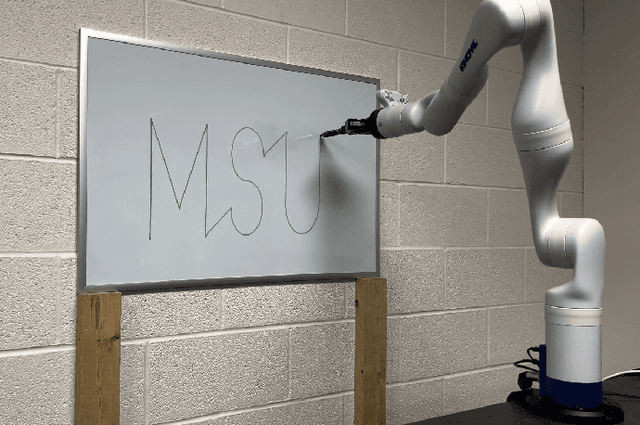
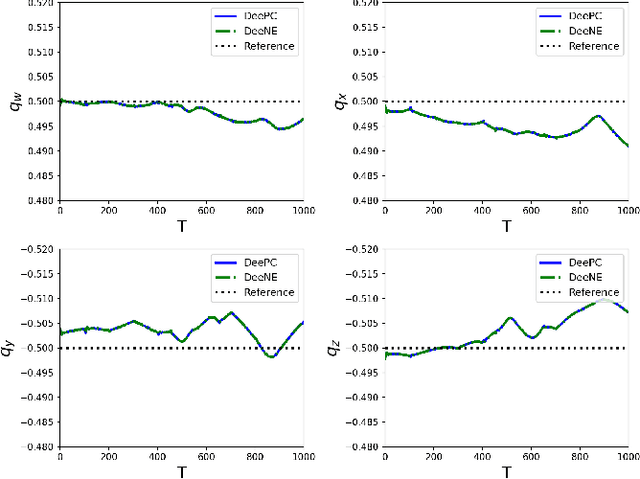
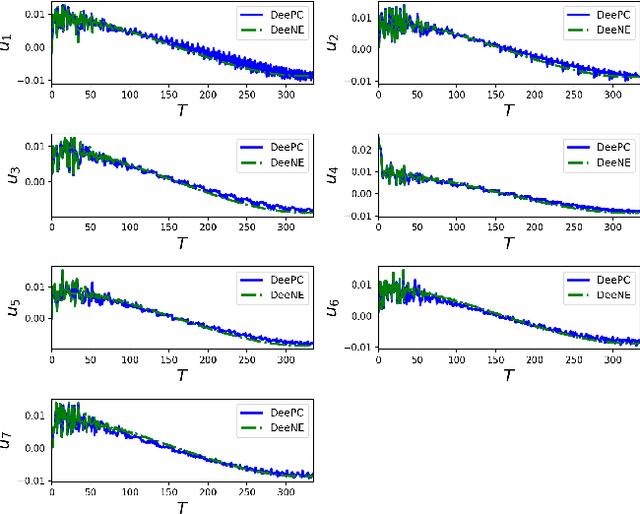
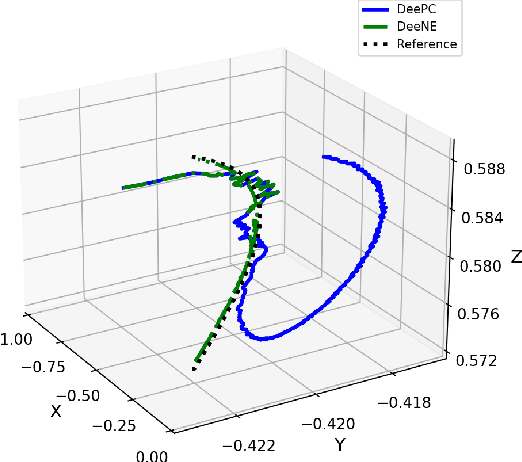
Abstract:Data-enabled predictive control (DeePC) has recently emerged as a powerful data-driven approach for efficient system controls with constraints handling capabilities. It performs optimal controls by directly harnessing input-output (I/O) data, bypassing the process of explicit model identification that can be costly and time-consuming. However, its high computational complexity, driven by a large-scale optimization problem (typically in a higher dimension than its model-based counterpart--Model Predictive Control), hinders real-time applications. To overcome this limitation, we propose the data-enabled neighboring extremal (DeeNE) framework, which significantly reduces computational cost while preserving control performance. DeeNE leverages first-order optimality perturbation analysis to efficiently update a precomputed nominal DeePC solution in response to changes in initial conditions and reference trajectories. We validate its effectiveness on a 7-DoF KINOVA Gen3 robotic arm, demonstrating substantial computational savings and robust, data-driven control performance.
Foundation Model-Based Apple Ripeness and Size Estimation for Selective Harvesting
Feb 03, 2025


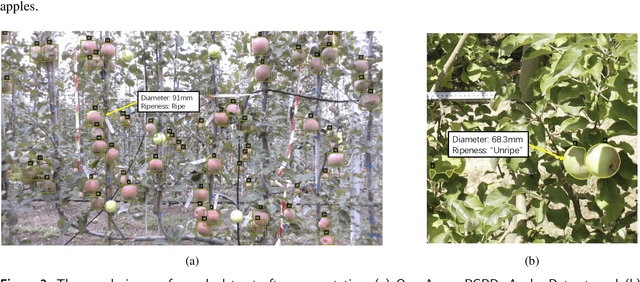
Abstract:Harvesting is a critical task in the tree fruit industry, demanding extensive manual labor and substantial costs, and exposing workers to potential hazards. Recent advances in automated harvesting offer a promising solution by enabling efficient, cost-effective, and ergonomic fruit picking within tight harvesting windows. However, existing harvesting technologies often indiscriminately harvest all visible and accessible fruits, including those that are unripe or undersized. This study introduces a novel foundation model-based framework for efficient apple ripeness and size estimation. Specifically, we curated two public RGBD-based Fuji apple image datasets, integrating expanded annotations for ripeness ("Ripe" vs. "Unripe") based on fruit color and image capture dates. The resulting comprehensive dataset, Fuji-Ripeness-Size Dataset, includes 4,027 images and 16,257 annotated apples with ripeness and size labels. Using Grounding-DINO, a language-model-based object detector, we achieved robust apple detection and ripeness classification, outperforming other state-of-the-art models. Additionally, we developed and evaluated six size estimation algorithms, selecting the one with the lowest error and variation for optimal performance. The Fuji-Ripeness-Size Dataset and the apple detection and size estimation algorithms are made publicly available, which provides valuable benchmarks for future studies in automated and selective harvesting.
High-Precision Fruit Localization Using Active Laser-Camera Scanning: Robust Laser Line Extraction for 2D-3D Transformation
Nov 15, 2023Abstract:Recent advancements in deep learning-based approaches have led to remarkable progress in fruit detection, enabling robust fruit identification in complex environments. However, much less progress has been made on fruit 3D localization, which is equally crucial for robotic harvesting. Complex fruit shape/orientation, fruit clustering, varying lighting conditions, and occlusions by leaves and branches have greatly restricted existing sensors from achieving accurate fruit localization in the natural orchard environment. In this paper, we report on the design of a novel localization technique, called Active Laser-Camera Scanning (ALACS), to achieve accurate and robust fruit 3D localization. The ALACS hardware setup comprises a red line laser, an RGB color camera, a linear motion slide, and an external RGB-D camera. Leveraging the principles of dynamic-targeting laser-triangulation, ALACS enables precise transformation of the projected 2D laser line from the surface of apples to the 3D positions. To facilitate laser pattern acquisitions, a Laser Line Extraction (LLE) method is proposed for robust and high-precision feature extraction on apples. Comprehensive evaluations of LLE demonstrated its ability to extract precise patterns under variable lighting and occlusion conditions. The ALACS system achieved average apple localization accuracies of 6.9 11.2 mm at distances ranging from 1.0 m to 1.6 m, compared to 21.5 mm by a commercial RealSense RGB-D camera, in an indoor experiment. Orchard evaluations demonstrated that ALACS has achieved a 95% fruit detachment rate versus a 71% rate by the RealSense camera. By overcoming the challenges of apple 3D localization, this research contributes to the advancement of robotic fruit harvesting technology.
Active Laser-Camera Scanning for High-Precision Fruit Localization in Robotic Harvesting: System Design and Calibration
Nov 04, 2023Abstract:Robust and effective fruit detection and localization is essential for robotic harvesting systems. While extensive research efforts have been devoted to improving fruit detection, less emphasis has been placed on the fruit localization aspect, which is a crucial yet challenging task due to limited depth accuracy from existing sensor measurements in the natural orchard environment with variable lighting conditions and foliage/branch occlusions. In this paper, we present the system design and calibration of an Active LAser-Camera Scanner (ALACS), a novel perception module for robust and high-precision fruit localization. The hardware of ALACS mainly consists of a red line laser, an RGB camera, and a linear motion slide, which are seamlessly integrated into an active scanning scheme where a dynamic-targeting laser-triangulation principle is employed. A high-fidelity extrinsic model is developed to pair the laser illumination and the RGB camera, enabling precise depth computation when the target is captured by both sensors. A random sample consensus-based robust calibration scheme is then designed to calibrate the model parameters based on collected data. Comprehensive evaluations are conducted to validate the system model and calibration scheme. The results show that the proposed calibration method can detect and remove data outliers to achieve robust parameter computation, and the calibrated ALACS system is able to achieve high-precision localization with millimeter-level accuracy.
ABatRe-Sim: A Comprehensive Framework for Automated Battery Recycling Simulation
Mar 14, 2023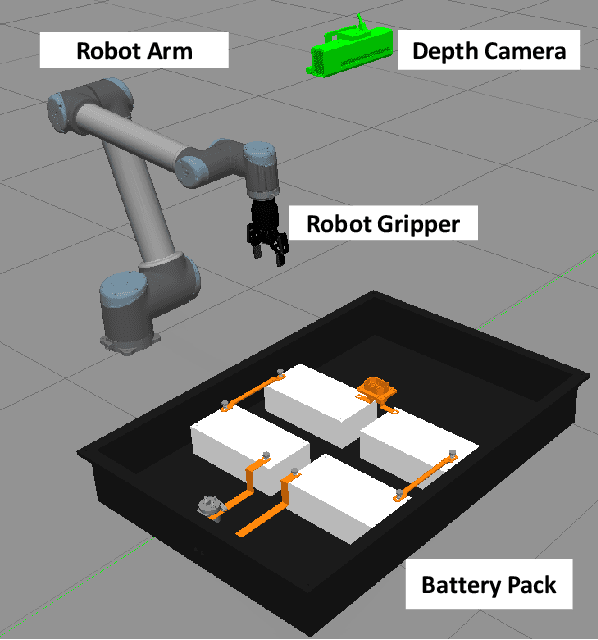
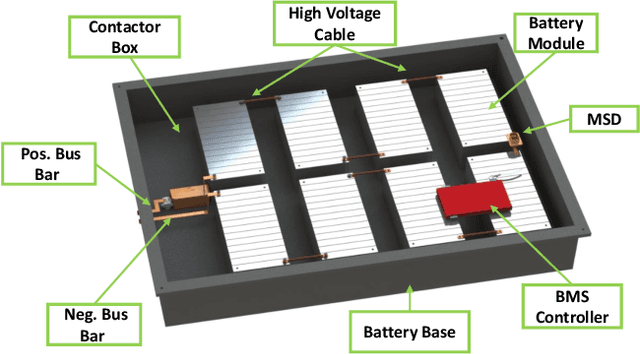
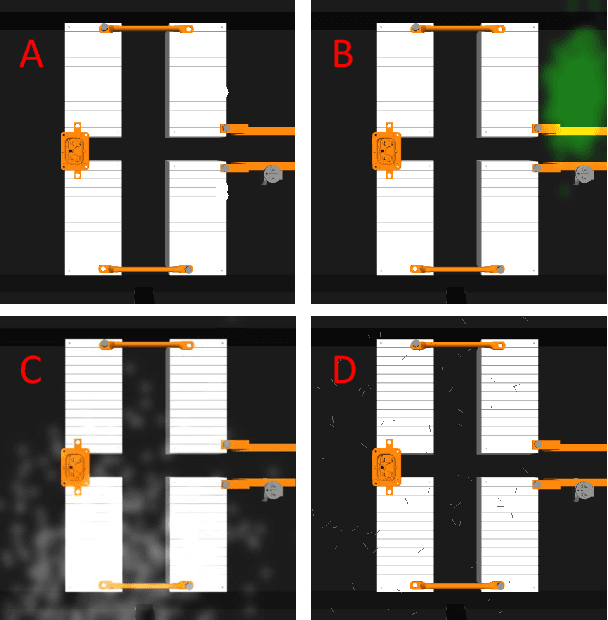
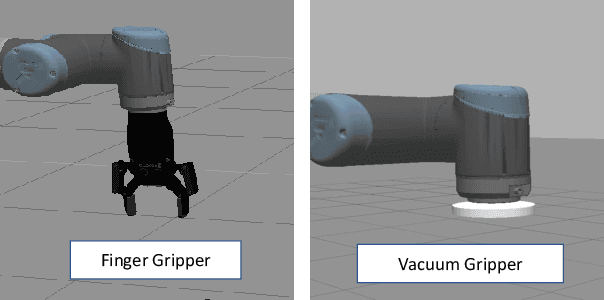
Abstract:With the rapid surge in the number of on-road Electric Vehicles (EVs), the amount of spent lithium-ion (Li-ion) batteries is also expected to explosively grow. The spent battery packs contain valuable metal and materials that should be recovered, recycled, and reused. However, only less than 5% of the Li-ion batteries are currently recycled, due to a multitude of challenges in technology, logistics and regulation. Existing battery recycling is performed manually, which can pose a series of risks to the human operator as a consequence of remaining high voltage and chemical hazards. Therefore, there is a critical need to develop an automated battery recycling system. In this paper, we present ABatRe-sim, an open-source robotic battery recycling simulator, to facilitate the research and development in efficient and effective battery recycling au-omation. Specifically, we develop a detailed CAD model of the battery pack (with screws, wires, and battery modules), which is imported into Gazebo to enable robot-object interaction in the robot operating system (ROS) environment. It also allows the simulation of battery packs of various aging conditions. Furthermore, perception, planning, and control algorithms are developed to establish the benchmark to demonstrate the interface and realize the basic functionalities for further user customization. Discussions on the utilization and future extensions of the simulator are also presented.
O2RNet: Occluder-Occludee Relational Network for Robust Apple Detection in Clustered Orchard Environments
Mar 08, 2023Abstract:Automated apple harvesting has attracted significant research interest in recent years due to its potential to revolutionize the apple industry, addressing the issues of shortage and high costs in labor. One key technology to fully enable efficient automated harvesting is accurate and robust apple detection, which is challenging due to complex orchard environments that involve varying lighting conditions and foliage/branch occlusions. Furthermore, clustered apples are common in the orchard, which brings additional challenges as the clustered apples may be identified as one apple. This will cause issues in localization for subsequent robotic operations. In this paper, we present the development of a novel deep learning-based apple detection framework, Occluder-Occludee Relational Network (O2RNet), for robust detection of apples in such clustered environments. This network exploits the occuluder-occludee relationship modeling head by introducing a feature expansion structure to enable the combination of layered traditional detectors to split clustered apples and foliage occlusions. More specifically, we collect a comprehensive apple orchard image dataset under different lighting conditions (overcast, front lighting, and back lighting) with frequent apple occlusions. We then develop a novel occlusion-aware network for apple detection, in which a feature expansion structure is incorporated into the convolutional neural networks to extract additional features generated by the original network for occluded apples. Comprehensive evaluations are performed, which show that the developed O2RNet outperforms state-of-the-art models with a higher accuracy of 94\% and a higher F1-score of 0.88 on apple detection.
Algorithm Design and Integration for a Robotic Apple Harvesting System
Mar 01, 2022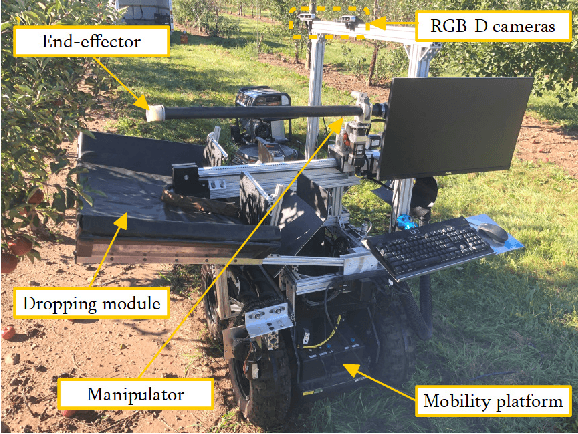
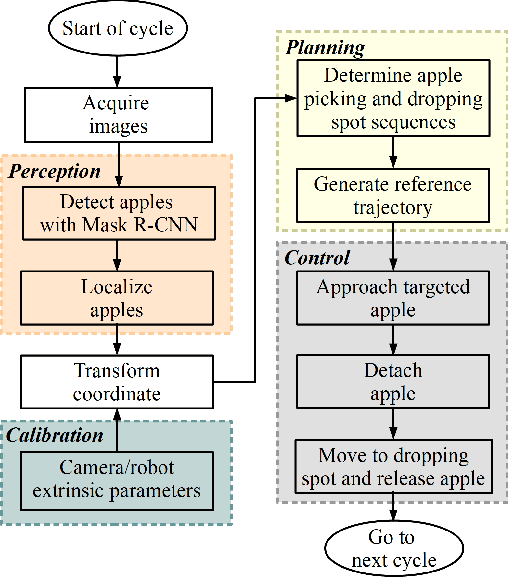
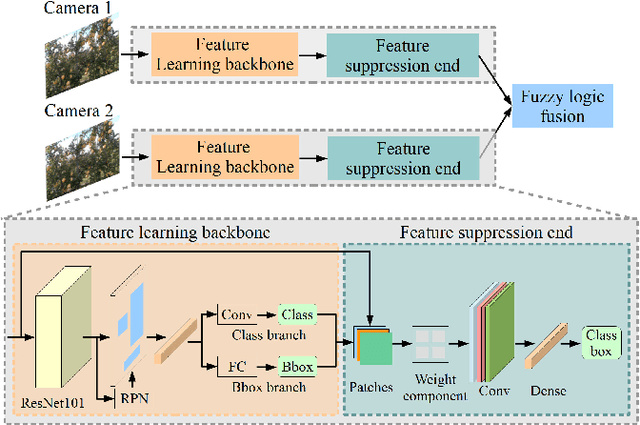
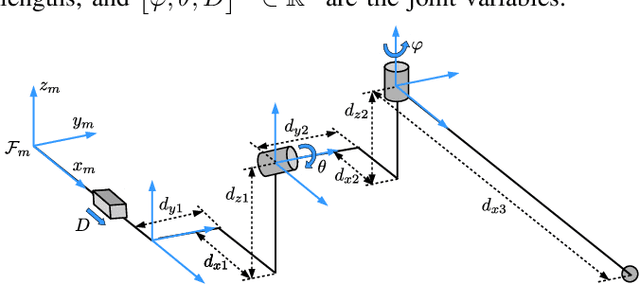
Abstract:Due to labor shortage and rising labor cost for the apple industry, there is an urgent need for the development of robotic systems to efficiently and autonomously harvest apples. In this paper, we present a system overview and algorithm design of our recently developed robotic apple harvester prototype. Our robotic system is enabled by the close integration of several core modules, including calibration, visual perception, planning, and control. This paper covers the main methods and advancements in robust extrinsic parameter calibration, deep learning-based multi-view fruit detection and localization, unified picking and dropping planning, and dexterous manipulation control. Indoor and field experiments were conducted to evaluate the performance of the developed system, which achieved an average picking rate of 3.6 seconds per apple. This is a significant improvement over other reported apple harvesting robots with a picking rate in the range of 7-10 seconds per apple. The current prototype shows promising performance towards further development of efficient and automated apple harvesting technology. Finally, limitations of the current system and future work are discussed.
MELONS: generating melody with long-term structure using transformers and structure graph
Nov 03, 2021

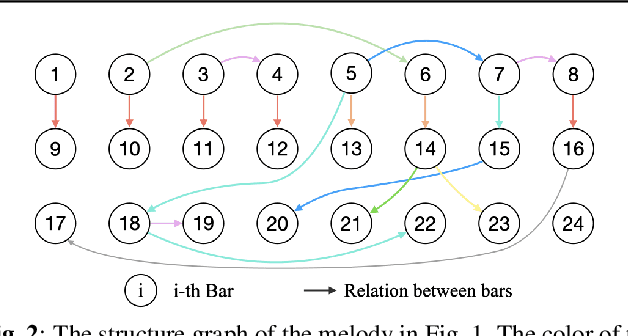
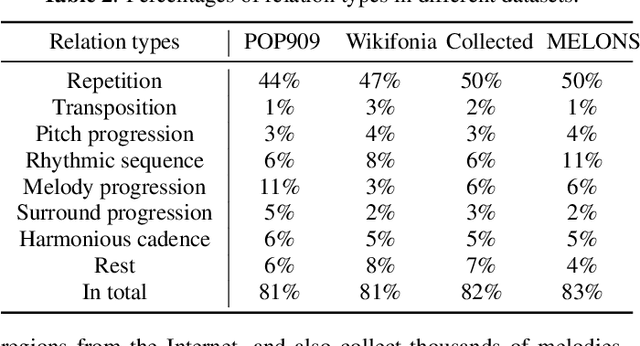
Abstract:The creation of long melody sequences requires effective expression of coherent musical structure. However, there is no clear representation of musical structure. Recent works on music generation have suggested various approaches to deal with the structural information of music, but generating a full-song melody with clear long-term structure remains a challenge. In this paper, we propose MELONS, a melody generation framework based on a graph representation of music structure which consists of eight types of bar-level relations. MELONS adopts a multi-step generation method with transformer-based networks by factoring melody generation into two sub-problems: structure generation and structure conditional melody generation. Experimental results show that MELONS can produce structured melodies with high quality and rich contents.
 Add to Chrome
Add to Chrome Add to Firefox
Add to Firefox Add to Edge
Add to Edge